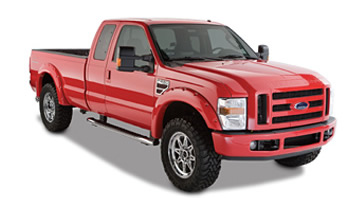CNG/LPG Vehicles
In this section
- Advanced Clean Diesel
- HEVs
- BEVs
- PHEVs
- Renewable Biofueled Vehicles
- CNG/LPG Vehicles
- FCVs

CNG/LPG Vehicles
Ford Super Duty Pickup
Vehicles that run on compressed natural gas (CNG) and liquefied petroleum gas (LPG – also called propane autogas) typically have lower emissions and lower fuel costs than gasoline and diesel vehicles. Ford offers engine packages specially prepared for conversion to run on CNG and LPG on many of our vehicles targeted to the commercial fleet market.
Technology Overview
Ford offers engine packages specially prepared for conversion to run on compressed natural gas (CNG) and liquefied petroleum gas (LPG – also called propane autogas), on many of our vehicles targeted to the commercial fleet market. CNG and LPG can help commercial vehicle fleets reduce their environmental footprint because they provide similar performance with significantly lower emissions. They can also help fleets reduce fuel costs, as they typically cost less on a gallon-equivalent basis than gasoline or diesel. Commercial fleets can also take advantage of centralized refueling and/or defined routes, which help address fueling infrastructure issues. Our gaseous-fuel-prepped engines include hardened components such as valves and valve seats that can withstand the higher operating temperatures and lower lubricity of gaseous fuels.
Our vehicles with gaseous-prepped engines can be converted to either dedicated alternative fuel systems, which can only run on either CNG or LPG, or to bi-fuel systems, which can run on the alternative fuel or on regular gasoline. Bi-fuel vehicles generally have longer range because they can continue to operate seamlessly on gasoline when the alternative fuel is not available.
Benefits
CNG and LPG vehicles have both environmental and economic advantages. Vehicles running these types of fuel have lower carbon dioxide (CO2) emissions and lower total greenhouse gas (GHG) emissions than gasoline or diesel vehicles. When running on CNG, our vehicles typically emit 19–21 percent less CO2 and 26–29 percent fewer total GHGs, according to our own internal tests. LPG-fueled F-series trucks typically emit 17–24 percent fewer total lifecycle GHG emissions, according to a study commissioned by the Propane Education and Research Council. CNG and LPG also reduce non-CO2 tailpipe emissions such as NOx, SOx, particulate matter and carbon monoxide.
CNG and LPG also have significantly lower fuel costs. CNG costs range from $1.08 to $2.40 per gallon on a gasoline gallon equivalent basis, resulting in up to a 73 percent reduction in fuel cost compared to using diesel or gasoline. Businesses using CNG-fueled trucks often see payback on the conversion cost in as little as 24 to 36 months of use. LPG costs approximately $2.00 per gallon, on a gasoline gallon equivalent basis, resulting in an up to 50 percent fuel savings per gallon compared to gasoline and diesel.
While CNG provides better GHG and fuel costs reductions, LPG can have other benefits. For example, LPG refueling systems typically cost significantly less to install. LPG fuel tanks are also smaller than CNG, resulting in less loss of cargo and/or passenger capacity.
Deployment
Interest in CNG and LPG vehicles is growing globally. In the U.S., for example, sales of Ford’s commercial vehicles with CNG/LPG prepped engine packages increased by more than 350 percent from 2009 to early 2013. In the U.S., we provide gaseous prepped engine packages as a factory installed option on select commercial vehicles. We work with qualified vehicle modifiers (QVM) to convert vehicles with gaseous prepped engines to CNG and LPG fuel systems. Ford has established a rigorous qualification program for QVMs that provides guidance, modification recommendations, and engine operating specifications required to ensure customer satisfaction and reliability in line with Ford Motor Company standards. We perform onsite assessments at each QVM location to ensure conformance to a high standard of manufacturing, assembly, workmanship and customer service. We currently work with six QVM suppliers for CNG conversions (Altech-Eco, BAF, IMPCO, Landi Renzo, Venchurs and Westport) and one QVM for LPG conversions (Roush Cleantech).
Ford’s approach to CNG and LPG vehicle conversions using QVMs offers a range of benefits. For example, the competition among QVMs has resulted in improved quality and reduced prices for conversion systems, as well as spurring innovation and technology improvements. This approach has made it possible for Ford to offer a much wider range of commercial vehicles with CNG and LPG than other full-line manufacturers.
In the U.S., Ford vehicles currently available with CNG and LPG gaseous fuel prepped engine packages include:
- Transit Connect, 2.0L (CNG only)
- E-Series Cargo Vans, 5.4L/6.8L
- E-Series Wagons, 5.4L/6.8L
- E-Series Cutaway & Stripped Chassis, 5.4L/6.8L
- F-Series Super Duty® Pickup & F-350 Chassis Cab, 6.2L
- F-Series Super Duty Chassis Cabs, F-450/550/650, 6.8L
- F53 & F59 Stripped Chassis, 6.8L
For the U.S. market, Ford is also currently developing CNG/LPG-prepped engine packages for:
- The all-new Ford Transit range of full-size vans, wagons, cutaways and chassis cab models with a 3.7L engine
- The next-generation Transit Connect lineup with a new 2.5L engine
- The 2014 Lincoln MKT Town Car Limousine and Livery packages with 3.7L engines
- Future F-150 trucks
In Australia, Ford offers LPG versions of the Falcon Ute commercial vehicle using Ford’s EcoLPi engine technology. In Europe, we offer CNG and LPG conversions of various models in markets where dedicated infrastructure exists, such as Italy, Germany and the Netherlands. In Germany, for example, we offer CNG bi-fuel versions of the Ford C-MAX and Focus. In India, we offer a bi-fuel CNG version of the Ford Ikon Flair.










